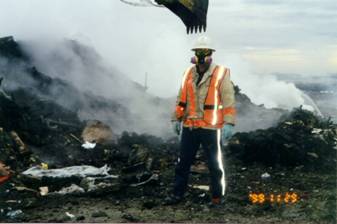|
REDUCING THE RISK OF LANDFILL FIRE
Health and Safety
Smoke
generated from landfill fires can contain toxic gases including
CO, H2S, CH4, and carcinogens such as Dioxins.
Proper respiratory protection is vital.
Dioxins,
more correctly known as polychlorinated dibenzo para-dioxins (PCDDs)
and polychlorinated dibenzofurans (PCDFs) are organic chemicals
that are highly toxic and cause serious health effects such as
cancer, birth defects, reproductive and developmental problems.
Dioxins are extremely long lasting molecules that remain in the
environment and bio-accumulate in the fatty tissue of humans as
well as other life forms. Dioxins can travel great distances
in air currents.
Dioxins
are produced when organic materials are burnt in the presence
of chlorine. For example, PVC, is a common plastic found
in MSW and C&D waste that contains both organic materials
and chlorine. Dioxins are known to be produced through low
temperature chemical processes, including disposal of MSW.
Dioxins can also be produced by thermal processes including MSW
combustion or incineration. Although typically generated
at combustion above 1472ºF (800ºC) dioxins can be produced at
lower combustion temperatures.
Dioxins
occur at extremely low concentrations and are therefore very difficult
and expensive to analyse. Rather than testing for dioxins,
I assume that dioxins may be present and wear respiratory protection
at all times when working a landfill fire, except when there is
a need to communicate.

Photo
3. Wearing
adequate protective equipment,
especially
respirator (cartridge type is important!!)

      next page
next page  Pre Planning
Pre Planning
|

